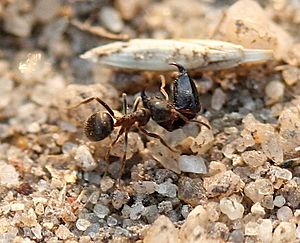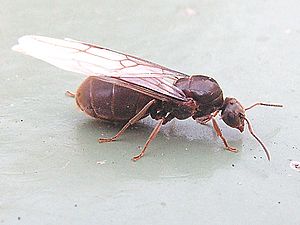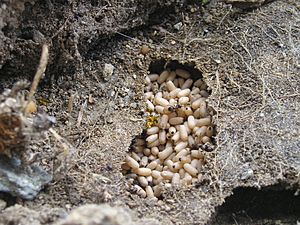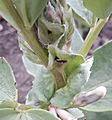Black garden ant facts for kids
Quick facts for kids Black garden ant |
|
|---|---|
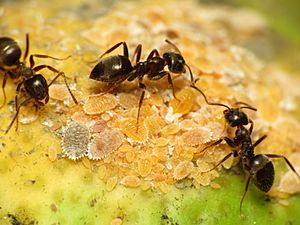 |
|
| Black garden ants tending to mealybugs | |
| Scientific classification |
The Black garden ant (Lasius niger) is a common type of ant. You might also hear it called the Common black ant or Common house ant. These ants live in many places around the world. You can find them in Europe, Asia, and even parts of South America and Australia. In Europe, scientists have split this ant into two types. L. niger lives in open areas, while L. platythorax prefers forests.
Black garden ants build their homes underground. They often choose spots under stones, but also rotten wood or tree roots. A single nest can hold up to 40,000 worker ants! However, most nests have about 4,000 to 7,000 ants.
Each colony has one queen ant. She can live for a very long time, up to 15 years. Some people even say they can live for 30 years! When a colony is new, there might be two or three queens living together. They usually get along until the first worker ants appear. Then, they will likely fight until only one queen remains. Worker ants in labs have lived for at least four years.
Contents
What Do Black Garden Ants Look Like?
Worker ants are shiny and black. They are quite small, about 3 to 5 millimeters long.
Queen ants are much bigger, about 9 millimeters long. They are also shiny black, with faint brown stripes on their belly (abdomen). After a queen mates, she breaks off her wings. She eats her wing muscles for food during the winter.
Male ants are 3.5 to 4.5 millimeters long. Queens only produce males for mating. They have a dark, shiny body that looks different from the workers. They also have delicate wings that stick out.
Ant Mating Flights
Ants mate while flying in the air. These special mating flights are also called "nuptial flights." For Lasius niger, these flights usually happen from June to September.
In North America, flights take place in the autumn. But in Europe, they happen during the hot summer months of July and August. Thousands of winged male and female ants can be part of these flights. After a queen has mated, she lands and looks for a good spot to dig a tunnel. Male ants usually live for only a day or two after the mating flights.
Building a New Nest
The queen ant removes her wings to help her dig. Once she has dug a tunnel, she blocks the entrance. Then, she digs a small room where she will lay her eggs.
The eggs hatch after about 8 to 10 weeks. The queen does not leave the nest to find food until her eggs have hatched. She also waits until the larvae have grown into ants. She survives by eating the protein from her own wing muscles.
From Egg to Ant
Like other ants, black garden ants go through four stages of life. These are: egg, larva, pupa, and adult.
The eggs are tiny, white, and shaped like a kidney. They have a smooth, sticky surface. This stickiness helps the queen carry them in a group. After hatching, the larvae look like tiny maggots. The queen (or workers in an older colony) must feed them so they can grow.
As they grow, larvae shed their skin, usually three times. Each time they shed, they grow hooked hairs. These hairs help them be carried in groups. When a larva gets too big, it is carried alone.
When it is big enough, the larva spins a cocoon around itself. The queen (or workers) might bury the larva to help it spin its cocoon without being disturbed. Once the larva has changed inside its cocoon, a new worker ant comes out. It is completely white at first, but it turns black in about an hour.
Starting a New Colony
The first worker ants born are very small. Later generations of ants grow much bigger. These new worker ants begin to make the nest larger. They also take care of the queen and her eggs.
They open the nest entrance and start looking for food above ground. They need to find food quickly to help the colony grow and to feed the hungry queen. The queen will have lost about half of her body weight.
The queen's only job in the colony is to lay more eggs. Later worker ants will be bigger, stronger, and more active. This is because they have more food while they are growing. Instead of only the queen looking after them, they have a team of workers. Some workers find food, and others care for the young. If workers can find enough food, the colony's population will grow very quickly.
After several years, when the colony is strong, the queen will lay eggs that become new queens and males. Black ants often build large nests with tunnels connecting different parts.
What Do Black Garden Ants Eat?
Black garden ants eat sweet things like nectar. They also eat small insects, such as codling moth larvae, and fruit. These ants are known to "milk" aphids, cockroaches, and beetles. This means they collect a sweet liquid called honeydew that these insects produce.
Images for kids
-
Lasius niger attending an extrafloral nectary on Vicia faba
See also
 In Spanish: Hormiga negra de jardín para niños
In Spanish: Hormiga negra de jardín para niños


